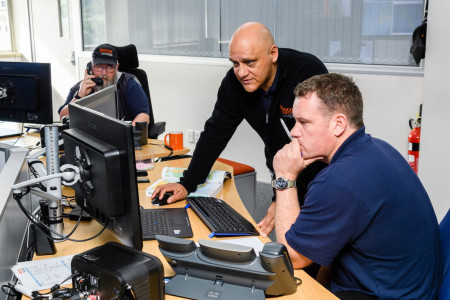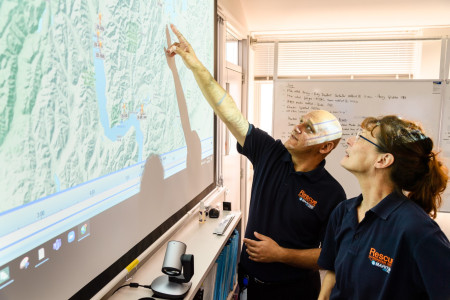Give it no longer than 15 minutes of trying to reach the pilot, then call us at RCCNZ.
By Tracy Brickles, Senior Search and Rescue Officer, Rescue Coordination Centre New Zealand.
Every year there’s a number of aircraft incidents where RCCNZ becomes involved only some time after the accident, when local searching has been unsuccessful.
The importance of contacting us quickly cannot be overstated. This step is part of your required emergency plan.
Don’t worry that it might be a false alert. Don’t think that you shouldn’t bother us. Delays in alerting us just means a delay in launching the initial search and rescue action, and that could have fatal consequences.
We’d much, much rather deal with a situation where our help turns out to be unneeded, than one where we’re advised after a delay that might prove crucial.
With an ATC service
If your aircraft is receiving an ATC service, as soon as it fails to make an expected report (from a visual reporting point, or to say it’s landed safely, or that it’s closing a SARTIME, or that it’s leaving controlled airspace) ATC will try calling the pilot and get other aircraft to try to call the pilot, and it’ll try the emergency phone number the pilot provided in the flight plan.
If, after 15 minutes, ATC has been unsuccessful, it’ll declare what’s known as an ‘uncertainty phase’ (INCERFA), and alert us at RCCNZ. We’ll then take over coordination of the incident.
Have an emergency plan
Whether or not your aircraft is receiving an ATC service, you’re required to have an emergency plan which you should test, ahead of an emergency, and make sure it’s fit-for-purpose.
A critical part of such a plan, when your aircraft isn’t receiving an ATC alerting service, is notifying us at RCCNZ, because in New Zealand, we’re the lead search and rescue (SAR) coordination authority for aviation and marine searches.
This is how your plan should go:
- Make initial checks – call the pilot / loader driver / farm station / airfield contact.
- After 15 minutes, call RCCNZ on 0508 472 269 or 04 577 8030.
- Advise us of the situation and have the relevant information available:
- Callsign/ aircraft registration
- Description of aircraft – colour, make and model
- POB
- Intentions – route, task
- Tracking systems/ADS-B
- Endurance
- Local weather.
What we do

A critical part of any emergency procedures plan, when your aircraft isn’t receiving an ATC alerting service, is notifying RCCNZ. From left, Ramon Davis, Watch Leader; Conrad Reynecke, Senior Search and Rescue Officer; and Dougal Cockrell, Search and Rescue Officer.
We’ll keep you in the loop as to our progress and plans.
As soon as we’re notified, we’ll start search and rescue action, including (but not necessarily in this order):
- Plotting the position/track of the aircraft.
- Calling the pilot’s contacts.
- Checking tracking systems – ADS-B provides accurate position information. (We have access to satellite ADS-B information direct from an accredited source).
- Requesting ATC to get other aircraft to call the overdue aircraft on 119.1 (or other appropriate frequency) and to listen out on 121.5MHz (this is the ELT homing signal if the ELT has been activated).
- Alerting the local police SAR co-ordinator who’ll liaise with us in developing a plan, including the use of ground searchers, if needed.
- Briefing and deploying search aircraft. This will include rescue helicopters, other local operators and, if required, the RNZAF.
- Possibly coming back to you, the operator, with further questions about, for instance, pilot experience, and their likely actions in a given situation.
- Advising the CAA so they can start any investigation and possibly help with gathering information.
Sending a friend to ‘go have a look’
Operators should avoid sending their own response until they’ve contacted RCCNZ.
When you do notify us, the duty search and rescue officer will discuss with you what aircraft and staff you have to help in the search. We’ll also be asking for any tracking information you have that could help us narrow down the search area.
We really don’t recommend that you deploy your own, or your friend’s, aircraft as an initial response.
The company’s pilots / friends will be emotionally invested in the search which may affect their decision- making. You don’t want to lose two aircraft.
Aircraft and pilots who’re part of the official search need a clear picture of which other aircraft are in the area, where they are, and what they’re doing.
For safety reasons, we deploy just one aircraft into a defined sector of the search area. If there are unknown aircraft in an area, it can hamper the official search.
When an ELT is activated

Delays in alerting RCCNZ just mean a delay in launching the initial search and rescue action, and that could have fatal consequences. From left, Conrad Reynecke, Senior Search and Rescue Officer; Tracy Brickles, Senior Search and Rescue Officer.
Five minutes after an emergency locator transmitter has been activated, we’ll receive an alert via satellite.
Each ELT has a unique code, so we’ll be able to plot its position, and phone emergency contacts of the pilot/aircraft, to let them know what’s happening and to gather more information.
Approximately 92 percent of ELT activations are false or inadvertent. These can be the result of things like hard landings, unintentionally knocking the ELT activation switch, activation during maintenance, or malfunction. These alerts can be dealt with quickly if the ELT is correctly registered with us.
However, many are not correctly registered. Sometimes the ELT is not registered with us at all. Or the emergency contacts included in the original registration information have changed but the details have not been updated.
Sometimes a new owner of an aircraft assumes changing ownership details with the CAA is sufficient. It isn’t.
What all that means is that, currently, we cannot trace the owners in about half of the ELT activations we receive.
Apart from putting the post-accident survival of the aircraft’s occupants at risk, you must not fly an aircraft if we don’t have updated ELT information. Check out rule 91.529 Aircraft emergency location system (AELS) and ELT.
Go to beacons.org.nz to register your ELT (emergency locator transmitter) or update its registration details.
Not doing so may cost lives.
The search and rescue officers at RCCNZ are happy to talk about any concerns or questions you might have regarding your emergency plan, or how we’ll respond to an aviation incident. Please call us on 0508 472 269 or 04 577 8030.

